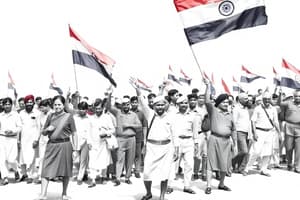Podcast
Questions and Answers
What was the main aim of the Non-Cooperation movement led by Gandhi?
What was the main aim of the Non-Cooperation movement led by Gandhi?
- To boycott foreign goods (correct)
- To seek higher positions in the colonial government
- To promote British goods
- To seek Dominion Status from the British
During which historical event did soldiers mutiny across Northern India and briefly capture Delhi?
During which historical event did soldiers mutiny across Northern India and briefly capture Delhi?
- Revolt of 1857 (correct)
- Non-Cooperation Movement
- Civil Disobedience Movement
- Quit India Movement
What was the outcome of the Quit India Movement initiated by Mahatma Gandhi in 1942?
What was the outcome of the Quit India Movement initiated by Mahatma Gandhi in 1942?
- Complete failure with no impact
- Increased British control over Indian resources
- Acceptance of Dominion Status by the British
- Mass surrendering of licenses and closure of European-owned factories (correct)
Which movement encouraged Indians to boycott foreign goods and public services run by the colonial administration?
Which movement encouraged Indians to boycott foreign goods and public services run by the colonial administration?
Why did the Quit India Movement eventually fizzle out?
Why did the Quit India Movement eventually fizzle out?
Which movement was launched in response to British misrule during World War I?
Which movement was launched in response to British misrule during World War I?
Flashcards are hidden until you start studying
Study Notes
Indian Freedom Struggle
The Indian independence movement was marked by several key events and strategies employed by nationalist leaders. Here we look at four significant aspects of this struggle: the Non-Cooperation movement, the Revolt of 1857, the Quit India Movement, and the Civil Disobedience movement.
Non-Cooperation Movement
In response to British misrule during World War I, Gandhi launched the Non-Cooperation movement with the aim of protesting against the Rowlatt Acts. This movement encouraged Indians to boycott foreign goods, refuse government jobs, and abstain from using public services such as schools run by the colonial administration.
Revolt of 1857
The Revolt of 1857 was one of the earliest major rebellions against British rule in India. It involved soldiers mutinying across Northern India and captured Delhi briefly before British reinforcements restored order.
Quit India Movement
This campaign started in August 1942 when Mahatma Gandhi called upon all segments of society to take part in nonviolent civil disobedience aimed at overthrowing British rule. In the face of widespread arrests it eventually fizzled out due to its unrealistic demands including rejection of any form of Dominion Status. However, before its failure it had some successes like mass surrendering of licenses, closure of many factories owned by Europeans, attacking European shops, etc.
Civil Disobedience Movement
During 1930, Gandhi began the Salt March from Ahmedabad to Dandi where he broke the salt law to encourage people to make their own salt. He also led campaigns against untouchability and promoted Hindu-Muslim unity leading up to his imprisonment in Yeravada Fort, Pune. Later on, Nehru joined him there and became more committed towards revolutionary action rather than constitutional methods which were responsible for his toppling Congress Party’s leadership later on.
These movements played crucial roles in shaping the course of Indian history and eventual independence from Britain. They demonstrated the power of peaceful resistance and inspired future generations of activists fighting oppression around the world.
Studying That Suits You
Use AI to generate personalized quizzes and flashcards to suit your learning preferences.



